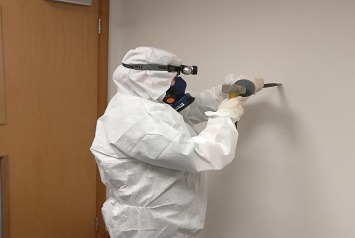
Do I need an Asbestos Survey?
If you are a building owner, an employer or you are responsible for having works carried out on your premises (construction, maintenance or repair works), you have a legal duty to manage any asbestos in it, so as to protect people from the exposure to asbestos fibres (Regulation 4 of the Control of Asbestos Regulations 2012).
The key to the management of asbestos is to identify the location, type, condition and extent of any Asbestos Containing Materials (ACMs). This is achieved by carrying out an asbestos survey. There are two types of surveys, an Asbestos Management or a Demolition/Refurbishment Survey. The type of asbestos survey conducted will be dependent upon the nature and the activities being carried out, or the proposed activities within your premises.
If your property was built after the year 2000, it is safe to presume that no asbestos is present, therefore an asbestos survey is not required.
Asbestos Management Survey
The purpose of an Asbestos Management Survey is to locate, as far as reasonable practicable the presence and extent of any suspected asbestos containing materials (ACM’s) in the building which could be damaged or disturbed during normal occupancy, including foreseeable maintenance and to assess their condition. For all non-domestic buildings built before 2000, an Asbestos Management Survey is always required.
Pre Refurbishment/Demolition Asbestos Survey
The purpose of the Pre-refurbishment or Demolition Survey is to locate, as far as reasonably practicable all Asbestos Containing Materials in the area where refurbishment work will take place or in the whole building if demolition is planned. This survey is intrusive and involves disturbing the fabric of the building.
Survey Preparation
As part of the survey preparation, the Asbestos Surveyor will request from the Client site specific information to enable a full and complete survey to be carried out, such information may include:-
- Details of buildings or parts of buildings to be surveyed and survey types(s).
- Details of building(s) use, processes, hazards and priority areas.
- Plans, documents, reports and surveys on design, structure and construction.
- Safety and security information, such as fire alarm testing, special clothing areas etc.
- Access arrangements and permits.
- Contacts for operational or health and safety issues.
Depending on the use, or proposed use of a building, a desk top survey may be undertaken to identify which areas of the building(s) require a more intrusive type of survey.
Carrying Out the Asbestos Survey
All Asbestos Surveys should be carried out in accordance with HSG264 (Asbestos: The Survey Guide). An Asbestos Surveyor carrying out survey work must be competent i.e. has the necessary knowledge, experience and qualifications to carry out the survey.
A detailed method statement and risk assessment must be undertaken and communicated to all parties prior to the survey. All Asbestos Surveys should be undertaken in a method/sequence appropriate to the building(s) and should include all areas; so far as reasonable practical.
Prior to starting the Asbestos Survey, the Survey Team should carry out a “walkthrough” of the premises to familiarise themselves with the size and layout of the building. Arrangements should be made to access any locked or secure areas; inaccessible areas will be noted within the Asbestos Survey Report.
The Lead Surveyor will work methodically through the building, floor by floor and room by room. When entering a room, the Surveyor will work typically, from the door in a clockwise direction checking walls, boxing’s, floors, ceilings and all fixtures and fittings.
All areas of the property will be surveyed including basements, loft spaces, external areas and outbuildings. As the survey proceeds, samples will be taken of any suspected asbestos containing materials. For each sample taken, details will be recorded on the survey paperwork such as, the material type, quantity, condition, location etc. The location of the sample point is identified on a building plan drawing and given a unique sample reference number before a record photograph is taken.
During the survey, should there be any areas of suspected asbestos fibre contamination, then the Surveyor should report this immediately to the Client/Duty Holder so that access can be restricted and appropriate action taken.
On completion of the survey, bulk samples taken of suspected Asbestos Containing Materials should be passed on to a UKAS accredited laboratory for analysis. Depending upon the urgency, Bulk Sample Analysis results can be provided within 1 to 5 days.
Asbestos Survey Report
An Asbestos Survey Report will be prepared following the survey and will include the Bulk Sample Analysis results.
The report will assist the building owner/occupier to manage asbestos containing materials (ACM’s) in their premises. Where asbestos containing materials are identified, then the report should include recommended remedial actions to be undertaken to mitigate any risks to those occupying the premises. This may include removing the asbestos containing material, encapsulating, or if the material is in a good condition, simply managing it.
The contents of the report must be communicated and made available to employees, maintenance workers or appointed contractors, so that they are aware of the presence of Asbestos Containing Materials. Where their works may potentially disturb ACMs, appropriate measures can be taken to prevent disturbance and the release of asbestos fibres.
Posted by: Tom Price, Head of Asbestos Management Services.
For further information on Asbestos Surveys, please contact Tom Price by phone 01332 668877 or email ([email protected]).

